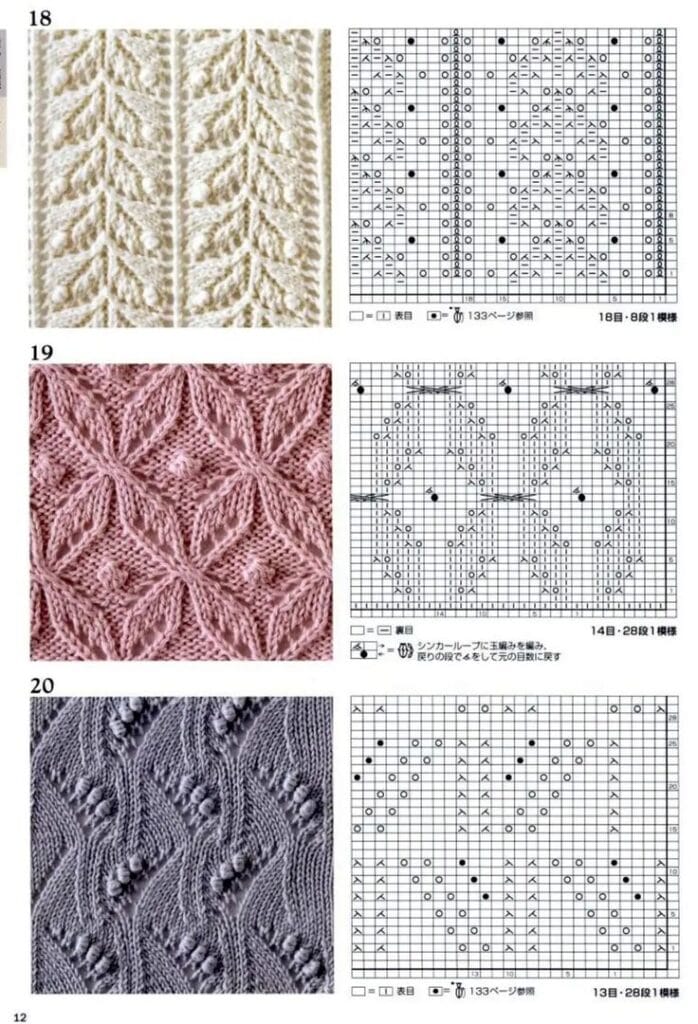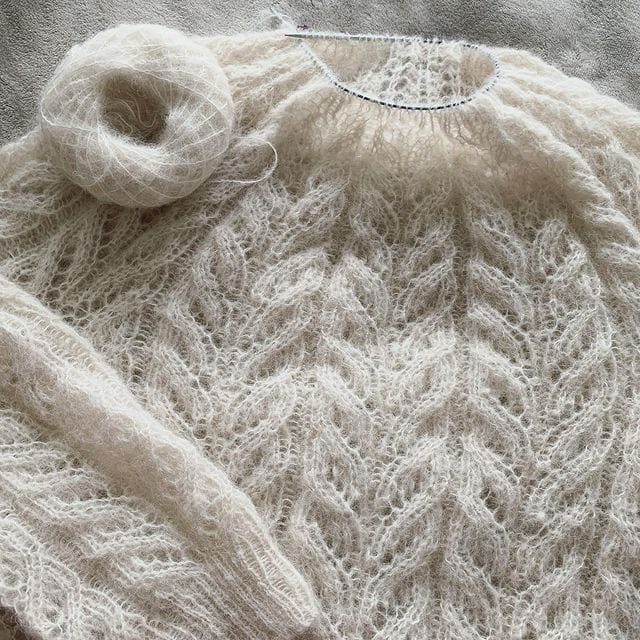Lace patterns have an undeniable allure: the delicate openwork, eye-catching motifs, and artistic drape can elevate even the simplest garments or accessories into something exquisite.
But if you’ve ever felt intimidated by lace—or attempted it and got tangled in yarn-overs—this post is for you.
Let’s dive into core techniques, the tools you’ll need, and how to fix common mistakes so you can easily craft breathtaking lace projects.
1. Why Lace?
- Versatility: Lace isn’t just for shawls—it appears in scarves, sweaters, socks, doilies, table runners, and beyond.
- Calming Rhythm: Once you get into the flow of lace repeats, it can be surprisingly relaxing—a perfect mindful project.
- Exquisite Detail: The intricate holes and swirling designs will surely draw compliments.
2. Essential Tools & Materials
Yarn Selection
- Lace-Weight Yarn: Traditional lace knitting often uses very fine yarn (e.g., mohair or alpaca blends).
- Heavier Weights: If you’re new to lace, try fingering or sport-weight yarn; the thicker strands make it easier to see stitches.
- Fiber Considerations: Wool and alpaca provide warmth and slight elasticity, silk or cotton enhances drape, and mohair adds a halo effect.
Needles & Hooks
- Knitting Needles: Look for pointy-tipped needles (stainless steel or lace-specific) that help you maneuver stitches easily. Circular needles are excellent for large shawls or stoles.
- Crochet Hooks: Fine steel hooks for delicate thread crochet lace or standard hooks for thicker yarn.
- Comfort & Grip: Try a few brands to see which needle or hook gives you the best tension control.
Notions & Extras
- Stitch Markers: Use them to separate pattern repeats or mark special sections in your lace chart.
- Lifelines: A lifesaver in complex patterns—thread a scrap yarn or dental floss through a row to “save” your place.
- Row Counters & Charts: Keeping track of rows is vital; many lace patterns rely on repetitive chart sections.
3. Understanding Lace Patterns & Charts

Written Instructions vs. Charts
- Visual Advantage: Charts let you see the laid-out lace pattern, making it easier to understand repeats.
- Line-by-Line Text: Some crafters prefer reading instructions exactly; if that’s you, ensure the pattern is written.
Reading Lace Symbols
- Common Increases & Decreases: YO (yarn over), K2tog, SSK, and SKP each create or shape the open holes.
- Crochet Symbols: ch, dc, sc, tr plus specialized symbols for picots or chain-spaces if you’re doing crochet lace.
- Right Side (RS) vs. Wrong Side (WS): Know which rows to place your pattern stitches on for symmetrical designs.
Swatching & Gauge
- Essential Step: Lace can grow significantly after blocking; your swatch helps predict this.
- Accurate Measurements: If you’re making a garment, gauge ensures you won’t have a too-loose or too-tight piece.
4. Key Lace Techniques & Stitches

Basic Increases & Decreases
- Yarn Over (YO): Creates the characteristic hole. Balancing YOs with decreases keeps your stitch count consistent.
- K2tog & SSK: Common knitting decreases that slant right (k2tog) or left (ssk). In crochet, the equivalent might be dc2tog or sc2tog in specific patterns.
Edging & Borders
- Knitted-On Edging: Some lace shawls feature separate edgings knit sideways onto the main body.
- Crochet Borders: Adding a simple chain-picot border can give your lace piece a neat finish.
Lifelines & Safety Lines
- When to Insert: Repeat a major pattern section after completing a chart.
- Why It Helps: If you make a mistake on row 20, you can safely return to the lifeline instead of redoing everything.
Advanced Stitch Patterns
- Nupps (Estonian Lace): A cluster stitch that adds texture.
- Beaded Lace: Thread beads onto yarn before knitting or add with a crochet hook for sparkle.
- Twisted Stitches: Small details that alter the look of lace for dramatic effect.
5. Troubleshooting Common Mistakes
Miscounting Stitches
- Stitch Markers: Place them between repeats to easily see where something went off.
- Row Counters: Apps or simple clickers help avoid losing track of complex patterns.
- Check Early: A quick stitch count at the end of each row can catch errors before they compound.
Dropped Yarn-Overs
- Identifying Missing YOs: If your pattern’s “holes” aren’t lining up, you might have skipped a YO.
- Fixing on the Next Row: Carefully lift the yarn between stitches to create the missed YO (if discovered promptly).
Unintended Gaps or Skipped Decreases
- Aligning Holes: Lace patterns usually form symmetrical holes. If they appear lopsided, re-check your chart.
- Using a Lifeline: If the mistake happened rows ago, a lifeline can save hours of frustration.
Irregular Tension or Holes
- Consistent Tension: Practice even tension on simpler projects before tackling intricate lace.
- Blocking: Minor unevenness often disappears after a proper block, which evens out stitches.
6. Finishing & Blocking for Lace
Why Blocking Matters
- Opens Up the Lace: Lace that looks scrunched on your needles often blooms once pinned out and dried.
- Shows Off Pattern: Your YOs and decreases will form crisp, well-defined motifs.
Blocking Techniques
- Wet Blocking: Fully soak your piece, gently squeeze out excess water, then pin in place on foam mats using T-pins or blocking wires.
- Steam Blocking: For more delicate fibers, carefully hover steam over your lace (avoid direct contact with iron if using synthetic or delicate yarn).
- Pin the Points: Shawls with scalloped edges might need blocking wires or pins at each “point” to maintain shape.
Care & Maintenance
- Hand-Wash vs. Machine: Most lace-weight or delicate fibers do best with gentle hand-washing in cool water.
- Re-Blocking: Over time, especially for garments, a quick re-block can refresh lace that’s lost its crisp shape.
7. Pattern Recommendations & Inspiration
Beginner-Friendly Lace Patterns
- Simple Scarf: A single, repeating lace motif that can be memorized quickly.
- Small Lace Cowl: An in-the-round project with a short height for easy finishing.
Intermediate & Advanced Projects
- Triangular Shawls: Popular in knitted lace, with charted borders and multiple repeats.
- All-Over Lace Sweater: For the adventurous knitter who wants to showcase lace in a wearable.
Selecting Patterns
- Well-Tested Sources: Reputable designers on Ravelry or pattern books with clear charts help minimize confusion.
- Support: Look for patterns with good notes or errata if needed—lace can be tricky if the instructions have errors.
8. Tips for Growing Your Lace Skills
Practice Swatch-Size Patterns
- Test Stitch Motifs: Trying out small lace motifs helps you internalize YO and decrease combos.
- Keep Notes: Document the needle size, yarn type, and chart you used for future reference.
Take It Slow
- Minimal Distractions: Lace typically needs focus—settle down with a good lamp and minimal background noise.
- Mark Your Progress: End each row or repeat with a quick stitch count or note in your row counter app.
Learn From Others
- Knit-Alongs & Crochet-Alongs: These group events often include tutorials, videos, and community Q&A.
- YouTube & Craft Groups: Video demonstrations can clarify tricky stitches. Local knit nights can offer hands-on guidance.
9. Conclusion & Call to Action
Recap Key Takeaways
- Tools & Techniques: Use pointy needles, lifelines, and stitch markers.
- Charts & Practice: Familiarize yourself with reading charts and practice on smaller swatches.
- Blocking: Don’t skip blocking—this step reveals the real magic of lace.
Experiment with Complexity
- Try beaded lace, color transitions, or advanced shawl shapes once comfortable.
- Share Your Work: Post your finished pieces on social media or in Lace KAL groups for encouragement and feedback.
Share your favorite lace patterns
- Share your favorite lace patterns or personal troubleshooting hacks.
- Offer a Free Pattern?: If possible, link to a simple lace scarf or cowl pattern for practice.
Final Thoughts
Mastering lace is about embracing the delicate interplay of stitches that form elegant openwork.
With the right needles or hooks, clear patterns, lifelines, and a good blocking session, your yarn transforms into something breathtakingly intricate.
Don’t be discouraged by the occasional mistake—lace is as much about the journey as the beautiful result.
So, pick your favorite yarn, grab those stitch markers, and get ready to open up a world of lace.
